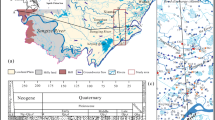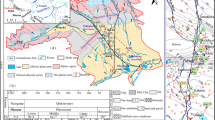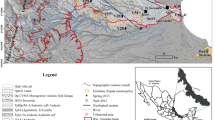Abstract
The importance of the chemical composition in evaluating groundwater flow is discussed. Two different geological environments, a felsic volcanic region around San Luis Potosí (SLPB), Mexico, and a sedimentary basin, part of the Pannonian Basin (PB), in Hungary, were chosen to explore the effect of local, intermediate and regional groundwater flows on the chemical evolution of water in different geological circumstances. In the study areas contrasting stable isotopes and groundwater temperature values, as well as the chemical composition of groundwater were convenient tools to propose groundwater flow direction and to study contamination processes in the different groundwater flow systems. Results indicate that regardless of the geological framework variability of the chemical composition of the shallow (<100 m) groundwater is significant; at depth the chemical content of groundwater becomes homogeneous, and the concentrations are smaller than at shallow depths. The Cl– and NO– 3 concentrations indicate mainly up- and downward vertical flow directions suggesting local flow systems in the shallow layers. The linear regression between Cl– and Na+ suggests that evaporation processes are the main control of the Cl– concentration. Deviations from the regression line suggest processes such as pollution at shallow depths in both study areas. Based on the distribution of Ca+2, Mg+2 and Na+, a lateral flow can be traced. The large dimensions of the geological units involved with the regional flow systems implies a long groundwater flow path, also these flows remain isolated from anthropogenic contamination, then groundwater has not been altered by human influence, although in the SLPB a communication between the local and intermediate flows has been found. Recharge areas of the local and intermediate flow systems are more vulnerable to contamination processes than the discharge areas, where the expected low dissolved oxygen content of ascending water could play a control. Differences in the lithology between the PB (sedimentary basin) and the SLPB (felsic volcanic basin) explain the contrasting saturation indices calculated for chalcedony and calcite and the lack of the expected development of HCO– 3, SO–2 4 Cl– facies and contrasting aerobic/oxidizing conditions.













Similar content being viewed by others
References
Appelo, C. A. J. (1988). WATEQP – A computer program for equilibrium calculations of water analyses. Amsterdam: Vrije Universiteit.
Appelo, C. A. J., & Postma D. (1996). Geochemistry, groundwater and pollution. Rotterdam: Balkema.
Back, W., Rosenshein, J. S., & Seaber, P. R. (Eds.) (1988). Hydrogeology: The geology of North America. Boulder, CO: Geological Society of America, 2, 524.
Cardona, A. (2006). Identificación y cuantificación de la recarga natural, urbana y por actividades agrícolas en las cuencas de San Luis Potosí-Villa de Reyes. Project SEMARNAT-2002-C01-0719.
Cardona, A. (2007). Hidrogeoquímica de sistemas de flujo regional intermedio y local, resultado del marco geológico en la Mesa Central: Reacciones, procesos y contaminación. PhD Thesis, Universidad Nacional Autónoma de México.
Cardona, A., & Carrillo-Rivera, J. J. (2006). Hidrogeoquímica de sistemas de flujo intermedio que circulan por sedimentos continentales derivados de rocas riolíticas. Ingeniería Hidráulica en Mexico, XXI(3), 69–86.
Carrillo-Rivera, J. J. (1992). The hydrogeology of the San Luis Potosí area, Mexico. PhD Thesis, University of London.
Carrillo-Rivera, J. J., Cardona, B. A., & Edmunds, W. M. (2002). Use of abstraction regime and knowledge of hydrogeological conditions to control high-fluoride concentration in abstracted groundwater: San Luis Potosí basin, Mexico. Journal of Hydrology, 261, 24–47.
Carrillo-Rivera, J. J., Cardona, B. A., & Moss, D. (1996). Importance of the vertical component of groundwater flow: A hydrogeochemical approach in the valley of San Luis Potosí, Mexico. Journal of Hydrology, 185, 23–44.
Chaudhuri, S., Furlan, S., & Clauer, N. (1992). The signature of water–rock interactions in formation waters of sedimentary basins: Some new evidence. Paper presented at the 7th International Symposium on Water–Rock Interaction, Park City, Utah, USA.
Edmunds, W. M., Carrillo-Rivera, J. J., & Cardona, A. (2002). Geochemical evolution of groundwater beneath Mexico City. Journal of Hydrology, 258, 1–24.
Edmunds, W. M., Cook, J. M., Darling, W. G., Kinniburgh, D. G., Miles, D. L., Bath, A. H., et al. (1987). Baseline geochemical conditions in the Chalk aquifer, Berkshire, U.K.: A basis for groundwater quality management. Applied Geochemistry, 2, 251–274.
Edmunds, W. M., Cook, J. M., & Miles, D. L. (1986). Lithium mobility and cycling in dilute continental waters. Paper presented at the 5th International Symposium on Water–Rock Interaction.
Erdélyi, M. (1979). Hydrodynamics of the Hungarian basin. Proceedings No. 18. of Vituki, Budapest.
Galvez, V., Hernández, A., & Blásquez L. (1941). Estudios hidrogeológicos practicados en el estado de San Luis Potosí. Instituto Panamericano de Geografía e Historia, Publicación 56, (Mexico, D. F.).
Kharaka, Y. K., & Carothers, W. W. (1986). Oxygen and hydrogen isotope geochemistry of deep basin brines. In P. Fritz & J. C. Fontes (Eds.), Handbook of environmental geochemistry, vol. 2. The Terrestrial Environment, B, (pp. 305–361) Amsterdam: Elsevier.
Lambert, S. J. (1991). Fossil meteoric groundwaters in the Delaware Basin of southeastern New Mexico. In H. P. Taylor, J. R. Jr. O’Neil, & I. R. Kaplan (Eds.), Stable isotope geochemistry: A tribute to Samuel Epstein (pp. 135–156). The Geochemical Society Special Publication no. 3.
Mata-Segura, J. L., López-Doncel, R., Rodríguez-Ríos, R., Arzate-Flores, J. A., & Pacheco-Martínez, J. (2004). Problemática de las fallas geológicas en la zona urbana y conurbana de San Luis Potosí-Soledad de Graciano Sánchez, IV Reunión Nacional de Ciencias de la Tierra, Juriquilla, Querétaro.
Parkhurst, D. L. (1995). User's guide to PHREEQC – A computer program for speciation, reaction-path, advective-transport, and inverse geochemical calculations. U.S. Geological Survey Water Resources Investigations Report 95–4227.
Rónai, A. (1985). The quaternary of the great Hungarian plain. Geologica Hungarica Series Geologica, 21, 446.
Stretta, E. J. P., & Del Arenal, R. (1960). Estudio para el abastecimiento de agua potable para la ciudad de San Luis Potosí. Applied Sciences Institute, UNESCO and Instituto de Geofísica, UNAM, Internal Report
Tóth, J. (1995). Hydraulic continuity in large sedimentary basins. Hydrogeology Journal, 3, 4–16.
Tóth, J. (2000). Las aguas subterráneas como agente geológico: Causas, procesos y manifestaciones. Boletín Geológico y Minero, 111(4), 9–26.
Tóth, J., & Almási, I. (2001). Interpretation of observed fluid potential patterns in a deep sedimentary basin under tectonic compression: Hungarian Great Plain, Pannonian Basin. Geofluids, 1, 11–36.
Varsányi, I. (1975). Clay minerals of the Southern Great Hungarian Plain. Acta Mineralogica Petrografica Szeged, XXII/1, 51–60.
Varsányi, I., & Kovács, O. L. (1997). Chemical evolution of groundwater in the River Danube deposits in the southern part of the Pannonian Basin (Hungary). Applied Geochemistry, 12, 625–637.
Varsányi, I., & Kovács, O. L. (2001). The source of sodium in groundwater, Pannonian Basin, Hungary. Paper presented at the 10th International Symposium on Water–Rock Interaction, Villasimius, Italy. Rotterdam: Balkema.
Varsányi, I., Matray, J. M., & Kovács, O. L. (1999). Hydrogeochemistry in two adjacent areas in the Pannonian Basin (Southeast-Hungary). Chemical Geology, 156, 25–39.
Viczián, I. (1982). An expanding mixed-layer clay mineral in Upper Pannonian to Pleistocene fine-grained clastic rocks of the borehole Pusztaottlaka I/P (SE Hungary). A Magyar Állami Földtani Intézet Évi Jelentése az 1980. évről, Műszaki Könyvkiadó, 449–457.
Acknowledgements
This work has been supported by the Scientific Research Fund (Hungary); grant numbers are T 037269 and K 60751. The Academia Mexicana de Ciencias also supported travel to carry out related discussions among the scientists involved. We also recognize the collaboration of the Earth Sciences Water and Soil Chemistry Laboratory staff of Facultad de Ingeniería-UASLP, in performing the water chemical analyses for samples collected for the San Luis Potosi study case; the Earth Sciences GIS lab provided help for the management of geographic information needed for the interpretation. The finantial support from CONACyT-SEMARNAT (Project 2002-C01-0719) is also appreciated.
Author information
Authors and Affiliations
Corresponding author
Rights and permissions
About this article
Cite this article
Carrillo-Rivera, J.J., Varsányi, I., Kovács, L.Ó. et al. Tracing Groundwater Flow Systems with Hydrogeochemistry in Contrasting Geological Environments. Water Air Soil Pollut 184, 77–103 (2007). https://doi.org/10.1007/s11270-007-9400-6
Received:
Accepted:
Published:
Issue Date:
DOI: https://doi.org/10.1007/s11270-007-9400-6




